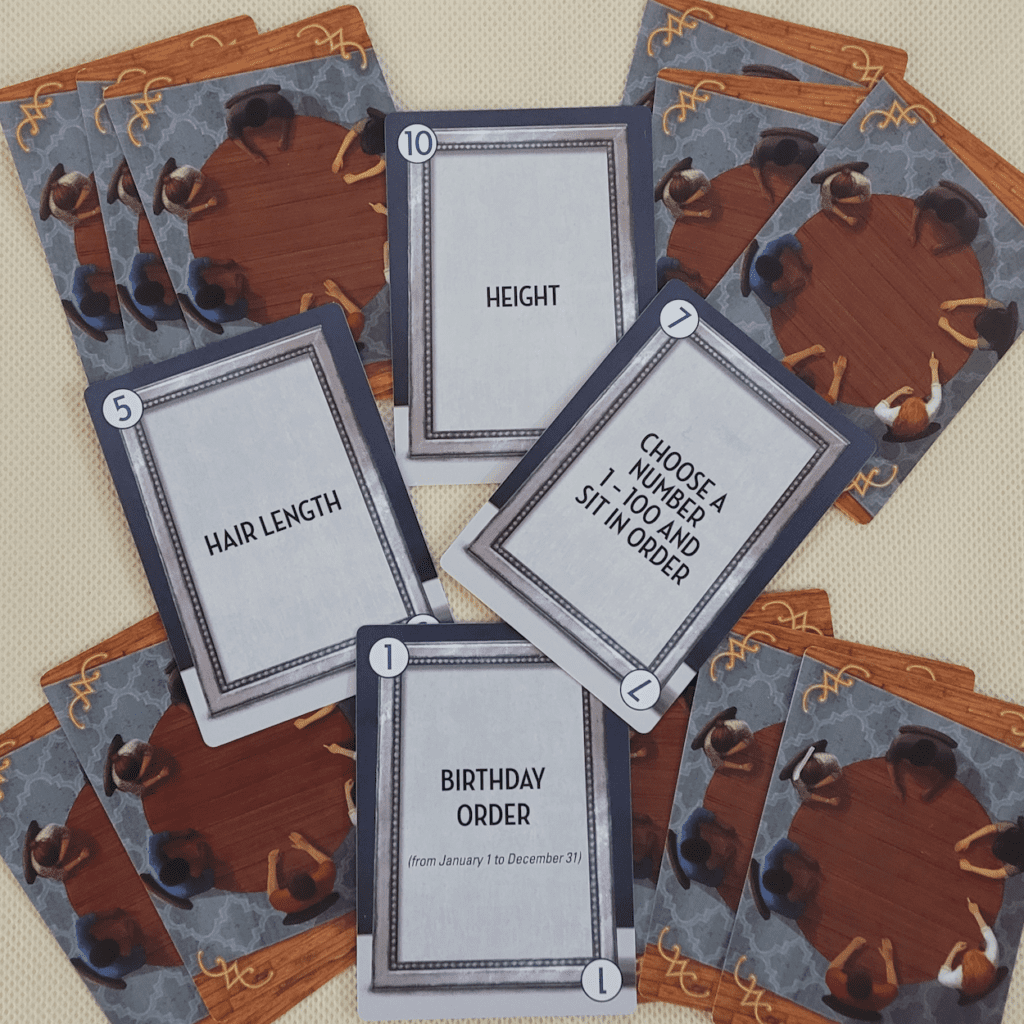Between Two Cities is a tile-drafting/tile-laying game in which you are collaboratively building two cities, one with the player on your left and one with the player on your right. Each player is attempting to make the livability (point value) of each of their cities as high as possible. In the end, each player’s score is the point value of the lower-valued city upon which they were working.
How to Play Between Two Cities
The seating arrangement is rather important. Before play begins, a card is drawn randomly from a deck of fifteen cards that will describe how to seat the players. Players could be arranged based on their birthdays, the length of their hair, or even a number they were asked to write down. Once everyone is seated, a set of duplex tiles (pieces that have two tiles on them and are played as a unit) are shuffled and placed face down on the table. The remaining singlet tiles are shuffled and placed face down in the box.

Each tile represents a type of building (Factory, House, Office, Park, Shop, or Tavern). When complete, each city will be made up of 16 tiles in a 4×4 grid – while playing, no tile may be placed in such a way as to cause the city to extend beyond 4 tiles wide or tall. The point value of each city is calculated based on how each type of tile met its goals (see below).

The game is played over three rounds. In each round, players will draw a hand of tiles and examine them. They will then select two of those tiles secretly and place them on the table. If the players have more than one tile left in their hand, those tiles are passed to the player to their left (round one) or right (round three). Once everyone has selected their two tiles, they will work with their partners to determine which one of their tiles goes into each city and where. Tiles must be placed so that all of the artwork is oriented the same way, and each tile placed after the first one must be adjacent to at least one previously placed tile. Once everyone has placed exactly one tile into each city, if they had tiles passed to them earlier in the round, they pick those up, pick two, and do it all again.

- In round one, players will draw seven singlet tiles into their hand. This means that round one will have three phases where players select two tiles and place one of them into each of their cities. At the end of round one, each city will have six tiles (three from each player building it).
- In round two, players will draw three duplex tiles into their hand. This means that round two will have one phase where players select two duplex tiles and place one of them into each of their cities. This is the round where the rule that tiles must be all oriented the same way can have an impact. At the end of round two, each city will have ten tiles (six from round one, and four more from round two).
- In round three, players will draw seven singlet tiles into their hand, just as they did in round one. At the end of round three, each city will be complete with 16 tiles.
End of the Game and Scoring
Once round three is over, each city in the game is evaluated and scored. Each of the six types of tile has its own scoring mechanism.
Some are scored based on how many are in the city (or how many are in other cities); some are scored based on the city’s variety; some need to be in groups while others just need to be there. Being adjacent to another type of tile can have an impact. All of this may seem a bit complex, but in practice, the scoring is rather straight-forward and goes rather quickly.
Once each city is evaluated, each player’s score is the lower score of the two cities they participated in building. The player with the highest score wins.
Production
Stonemaier Games started with Viticulture, then came Between Two Cities. The production values in these two games set the standard for the company. The tiles are large enough to see the details and information; thick enough to feel hefty in your hand. The rule book is excellent, being well written, having a well designed layout, and printed on very nice paper. In our first game, and in teaching this to new players, everything was clear and easy to understand. All of our initial questions were easily answered by the reference page on the back cover.
There is a scoreboard that has little use until the end of the game. During scoring you will have a pair of small meeple-like markers that are in the shape of a landmark of note; one of these markers is placed next to each city, and the duplicate is used to indicate the score of that city along the scoreboard. The markers are quite beautiful, resulting in some discussion as to who gets what landmark – it reminded me of my childhood when we would all want to be the “car” or the “horse” in Monopoly.

Cooperative? Competitive?
I have played this game several times at a variety of player counts. The game can handle 3-7 players (there is a two player variant I have not attempted). My experience suggests that this is a the-more-the-merrier kind of game. It plays fine at three players, but it does not really start to shine until you get to five players.
I believe this is due to the cooperative portion of this game. Once players have the tiles in their hands and they are looking at the two cities they have to build, the conversations begin. Working with their neighbors, each player is trying to get the most value out of each city. This results in each turn being lively and fun as each player makes their case for which tiles should be played where. While one might think this could result in some harsher moments, in my experience, conversations are constructive and cordial. Players smile and laugh as they attempt to place tiles in the most productive way for both of their cities.
When the final scores are calculated, everyone at the table gets invested in the outcome of all cities. There are ‘oohs’ and ‘aahs’ expressed as players see how other cities were optimized (or not!); everyone watches as the point values rise and the city rankings fluctuate. Everyone walks away feeling pretty good from the winner down to the player who ended up in last place.
In purely competitive games, I have seen groups where everything ends politely, but you can tell some were a bit disappointed in the results. That is not the case here. Even when you lose, you feel pretty good. Maybe it is because someone else shared in the city you were scored for? Maybe it is because you had a city that did better than your score would indicate? I am not sure. But in the end, this is always a good time.











Thank you for the commentary on this game K. David. It’s nice to have you contributing to the site as a writer and not only as our best cheerleader. Welcome aboard, and congratulations on your first (of many?) review.
Thanks! And yes, I am working on a couple more articles/reviews now. I’ll let you know when they are ready to be seen by someone other than me. 🙂
Welcome aboard (officially) K. David! An excellent review to start here on MeepleMountain.
Thank you so very, very much! It is a pleasure to be here.
Congrats on the first published review, K. David! Happy to see your name on the contributors list.
Thank you! And I am very happy to be in such esteemed company!
Good stuff man! This game is a classic. Looking forward to your next few articles sir!
Thank you so much! Looking forward to being a part of the team!